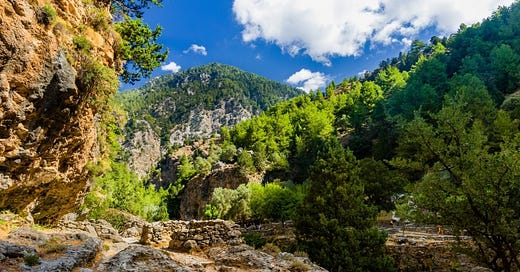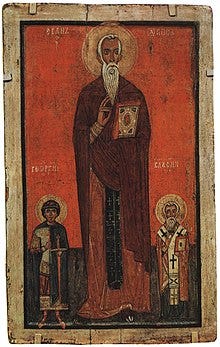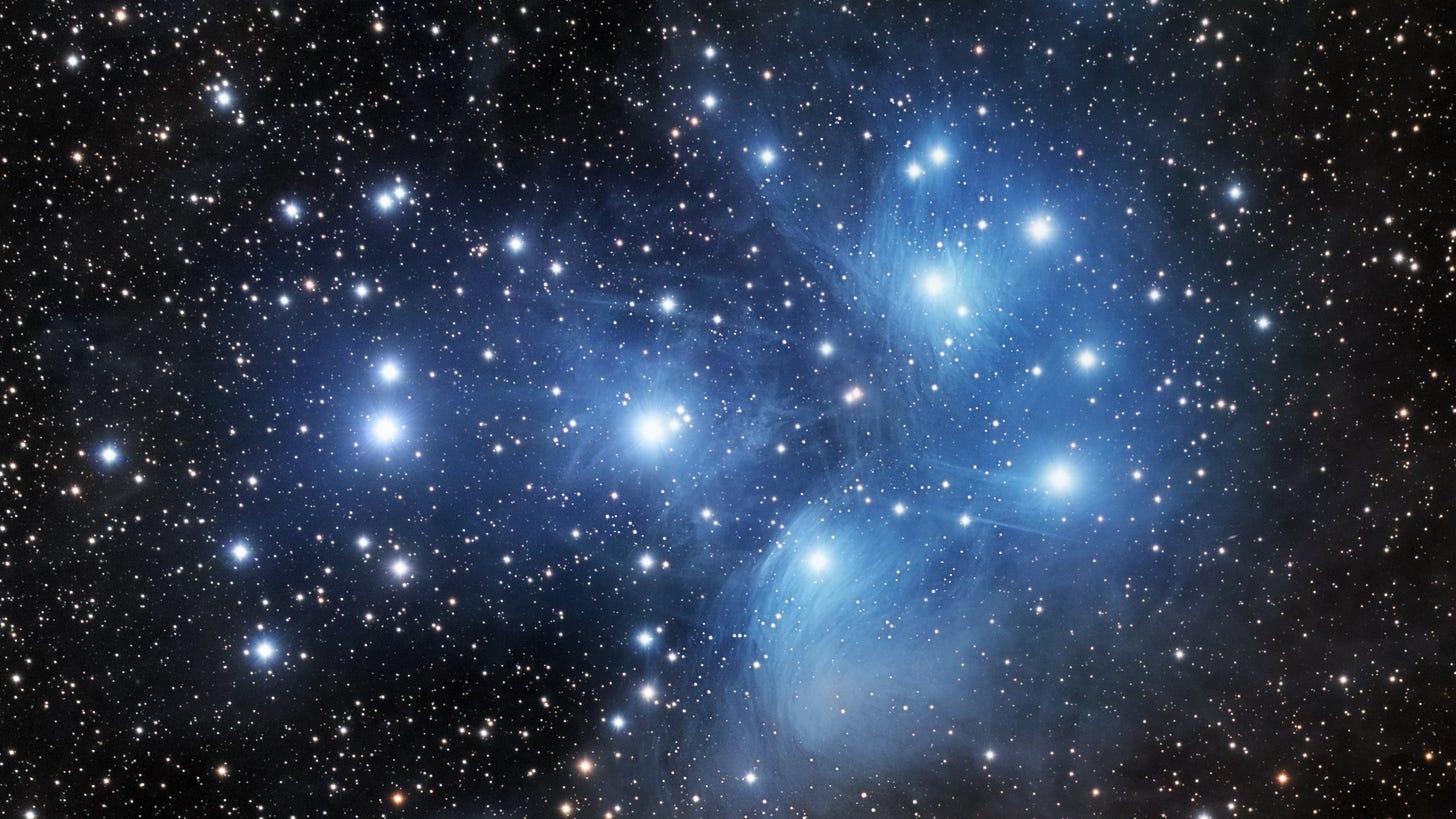“The whole earth is a living icon of the face of God.”
— St. John of Damascus, Treatise
1 Corinthians 15:47-57 (Epistle, Departed)
47 The first man was of the earth, made of dust; the second Man is the Lord from heaven.
48 As was the man of dust, so also are those who are made of dust; and as is the heavenly Man, so also are those who are heavenly.
49 And as we have borne the image of the man of dust, we shall also bear the image of the heavenly Man.
50 Now this I say, brethren, that flesh and blood cannot inherit the kingdom of God; nor does corruption inherit incorruption.
51 Behold, I tell you a mystery: We shall not all sleep, but we shall all be changed –
52 in a moment, in the twinkling of an eye, at the last trumpet. For the trumpet will sound, and the dead will be raised incorruptible, and we shall be changed.
53 For this corruptible must put on incorruption, and this mortal must put on immortality.
54 So when this corruptible has put on incorruption, and this mortal has put on immortality, then shall be brought to pass the saying that is written: “Death is swallowed up in victory.”
55 O Death, where is your sting? O Hell, where is your victory?
56 The sting of death is sin, and the strength of sin is the law.
57 But thanks be to God, who gives us the victory through our Lord Jesus Christ.
John 5:24-30 (Gospel, Departed)
24 Most assuredly, I say to you, he who hears My word and believes in Him who sent Me has everlasting life, and shall not come into judgment, but has passed from death into life.
25 Most assuredly, I say to you, the hour is coming, and now is, when the dead will hear the voice of the Son of God; and those who hear will live.
26 For as the Father has life in Himself, so He has granted the Son to have life in Himself,
27 and has given Him authority to execute judgment also, because He is the Son of Man.
28 Do not marvel at this; for the hour is coming in which all who are in the graves will hear His voice
29 and come forth – those who have done good, to the resurrection of life, and those who have done evil, to the resurrection of condemnation.
30 I can of Myself do nothing. As I hear, I judge; and My judgment is righteous, because I do not seek My own will but the will of the Father who sent Me.
4th Sunday of Great Lent: St John Climacus (of the Ladder)
The Fourth Sunday of Lent is dedicated to Saint John Klimakos, the author of The Ladder of Divine Ascent. In this book the Igoumen of Saint Katherine’s Monastery on Mount Sinai bears witness to the great effort which is required for entry into God’s Kingdom (Matthew 10:12). The spiritual struggle of the Christian life is difficult since it is “not against flesh and blood, but against ... the rulers of the present darkness ... the hosts of wickedness in heavenly places ...” (Ephesians 6:12). Saint John encourages the faithful in their efforts for, as the Lord has said, only “he who endures to the end will be saved” (Matthew 24:13).
Saint John was born around the year 525, the son of devout and wealthy parents. He received a very good education, but at the age of sixteen, he forsook the world and went to Mount Sinai, subjecting himself to the spiritual guidance of Elder Martyrios. When he was nineteen years of age,1 his Elder reposed. Then Saint John entered the arena of hesychasm, visiting the monastic communities of Skḗtē and Tabénnisē in Egypt. For another forty years, he lived in a cell at Thora in the Sinai Desert, which was a two hour (5 mile) walk from the Monastery of Saint Katherine.
Aflame with indescribable longing for God, he ate everything that was permitted by the monastic Rule, but only in very small quantities, and not unto satiety. By so doing, he overcame the vice of pride; and by eating just a little food, he humbled the stomach, which always wants more. He raised his body from death and paralysis by the remembrance of death, and he overcame the tyranny of anger with the sword of obedience.
Who can describe the fountain of his tears, which is now to be seen in very few individuals? He slept only as much as was necessary to prevent his mind from being distracted. Before going to sleep he prayed a great deal, and he also wrote books. This was how he subdued despondency. His entire life was spent in unceasing prayer, and incomparable love for God.
After writing The Ladder at the request of Igoumen John of Raithu Monastery, and leading a God-pleasing life, Saint John fell asleep in the Lord when he was about seventy-five years old (ca. 603). He is also commemorated on March 30.
The inscription on his icon is from Step 7:2. It reads: "Compunction is a perrenial trial of the conscience, which brings about the cooling of the fire of the heart through mental confession. And confession is a forgetfulness of nature, since someone because of this forgot to eat his bread."2
1 This was his monastic age. He was, in fact, thirty-five years old.
2 Psalm 101:5 (Septuagint) "Him that speaks privily against his neighbor, him have I driven from me; he that is proud in look and insatiable in heart - with him I have not eaten."
Saints as Stars / Saint John’s Ladder of Ascent
By His Eminence Metropolitan PANTELEIMON of Antinoes
When we are out in the country, enjoying the peace and quietness of nature, and it is night and the sky is clear, we often look up at heaven and gasp in amazement at the magnificent vista of stars before us. The stars were created on the fourth day, or we could say during the fourth period of Creation (Gen. l:l4-l9).
According to Astronomy, which is the science that studies the stars, they are nothing but suns which differ from each other in size and brightness. We start with the small ones, which are called Dwarfs and progress, to the largest, which are known as Red Giants.
Just as in the physical heaven we have different sized stars, so in the spiritual heaven, where the Saints are the Stars and they differ from each other in terms of virtues. The Church is the image of Heaven and as such displays before us a vista of spiritual stars or Saints. The Saints are the men and women who in and through their lives, glorified the Holy Trinity. This means they had imitated in their lives the life of our Lord Jesus Christ. Through true faith, love and forgiveness of one another, the Saints proved that God also glorifies those who glorify Him. The Saints were men like us who struggled for their daily bread and those that were married strove to raise Christian families.
However, they differed from us in the following ways: First, they always put the glory of Jesus Christ foremost. Secondly, they were always faithful children of His Orthodox Church, never doubting His Teachings. Thirdly, they never gave first place to material riches and enjoyments. Fourthly, they never departed from the true teachings and Church. And were ever ready, should the occasion arise, to sacrifice their lives to confess their faith in our Lord. For these reasons, the Church honors these holy men and women, not only in Heaven, but on Earth, because they honored God.
The Orthodox Church does not worship the Saints or the Mother of God, the Virgin Mary. The Church honors them and shows them respect, because of their faith in Christ. The Orthodox Church worships only the Holy Trinity. The Saints are the faithful children of the Church who in their lives bore spiritual fruit. They were not content merely to read the Holy Scriptures and to hear the word of God, but determined to put their faith into practice. They actualized what they read in the Scriptures and heard preached in the Church.
Today, the Orthodox Church draws our attention to one of Her faithful children, namely St John, the author of the book called “The Ladder of Perfection or Climax”. Let us look at the life of St John and see what message he has to offer us today.
St John was born in Palestine in 523 A.D. At the age of l6 he left the world and went to Mount Sinai where he placed himself under obedience to the wise Abbot of St Catherine’s Monastery. This Monastery has for over l,600 years now been a spiritual heaven for thousands of pious monks who came in search of the true spiritual life. Mount Sinai has always been the scene of Jewish, Moslem and Christian devotion. It was here that Moses first talked with God and received divine assurance of Jewish liberation from Egyptian bondage. Moses also received the Ten Commandments on Mount Sinai; the Prophet Elijah found refuge at this sacred spot in the desert from the Queen Jezebel. It was to this magnificent spot on Earth that St John of the Ladder came and lived a life of dedication and prayer, first under the guidance of the saintly Abbot, and then as a hermit in the wilderness.
He remained for fifty (50) years in a cave, and people from all over the world came to hear his words of wisdom. During the latter part of his life, he wrote his famous book of Spiritual exercises entitled “The Ladder of Perfection or Climax”. The ladder of which he writes was symbolic of a spiritual ladder leading from earth up into heaven. It consisted of spiritual exercises through which the Christian could reach the highest point of spiritual perfection and thus become a participant of the Κingdom of Heaven. Many monks throughout the world still utilize this tremendous work of St John in their spiritual meditations.
The work itself is considered one of the most inspired gems of Christian literature. St John of the Ladder died on March 30th, at the age of 86 years, 609 A.D. We celebrate his feast day, however, on the 4th Sunday of Lent, during which many of his spiritual exercises are used in many monasteries and Churches throughout Orthodox Christendοm.
Through his personal experience of the spiritual life, St John became one of the greatest scholars and Fathers of the Orthodox Church. Many Orthodox Christians today wish to live a more spiritual life in Chist. The Orthodox ascetic life as expounded in the writings of St John Climacus will provide them, l385 years after his death, with what they are looking for. Whoever truly wishes to live a spiritual life in Christ need do nothing more than study the lives of the Saints.
He will see how to practice the word of God, according to his strength. Careful study of the lives of the Saints will enable him to choose freely the way of his own sanctification. The lives of the Saints are nothing but the Gospel in practice. St John offers us through his life and writings the opportunity to lead a stricter Christian life.
This week’s calendar reminders:
Monday 3/24: Vesperal Liturgy for Annunciation of the Most Holy Theotokos 6:30 p.m. (potluck meal to follow)
Tuesday 3/25: no services or events
Wednesday 3/26: Presanctified Liturgy 6:30 pm (potluck meal to follow)
Thursday 3/27: Lenten Matins 8:30 am
Friday 3/28: Paraklesis to the Theotokos 8:30 am
Saturday 3/29: Catechumen Class 4:30 pm; Choir Rehearsal 4:30 pm; Great Vespers 6 pm
Sunday 3/30: Divine Liturgy 9:15am;
CLICK BELOW to donate online:
Christ the Savior Orthodox Church is located in Southbury, Connecticut, and is part of the New England Diocese of the Orthodox Church of America.
Mailing address: Christ the Savior Church, 1070 Roxbury Road, Southbury, CT 06488
PLEASE DONATE to help our parish do the work of the Lord, thrive and grow, and extend the Kingdom of God. May the Lord bless your generosity!
Fr. Moses Locke can be reached at frmoseslocke@gmail.com












